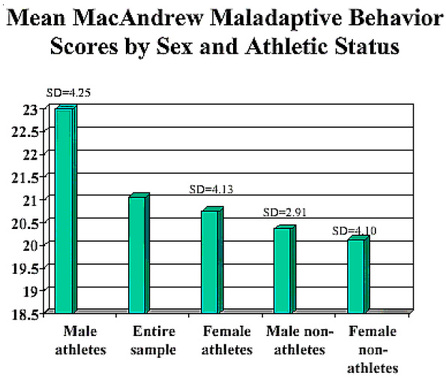Acknowledging the potential influence that sports stars may have on youth, Stephen Weiss set out to determine the prevalence of risk behaviors among a sample of college athletes and non-athletes. He cites several well-publicized cases of professional athletes becoming involved in gambling, the risk activity that seems to interest Weiss the most. He drew his sample of 200 students from the University of Connecticut’s Stamford campus, and administered the MacAndrew Alcoholism Scale. The MacAndrew instrument, the author explains, does not merely measure alcoholic behavior. Rather, it is a fair estimate of one’s propensity toward “maladaptive behavior.” The results are presented in the chart below.
The MacAndrew scale ranges from 0 to 49, with the latter score indicating the highest possible level of maladaptive behaviors. As a group, athletes scored significantly higher than non-athletes (Mmale=21.87, Mfemale=20.24; F1,196=8.77, p=.003), and men scored significantly higher than women (M=21.68, M=20.43; F1,196=5.16, p=.024). The variables of sex and athletic status showed no statistically discernible interaction. Five of the 200 individuals surveyed scored 30 or above, a level indicating excessively high levels of maladaptive behavior. 
Should this study send a warning message to the nation’s athletic directors? Unfortunately, the nature of the study does not specify which maladaptive behaviors are most prevalent and harmful for student athletes. Without this specificity, it is difficult to operationalize the present findings. While prevention and treatment measures can be implemented for individual behaviors such as pathological gambling, alcoholism, and other substance abuse problems, the broad category of maladaptive behavior is problematic. Of course, prevention and treatment are not the stated goals of the study. Nevertheless, the results should encourage others to investigate pathologies in this very visible and influential segment of society.
Source: Weiss, S.M. (1999). A comparison of maladaptive behaviors of athletes and nonathletes. The Journal of Psychology, 133(3), 315-322.
This public education project is funded, in part, by The Andrews Foundation and the National Center for Responsible Gaming.




